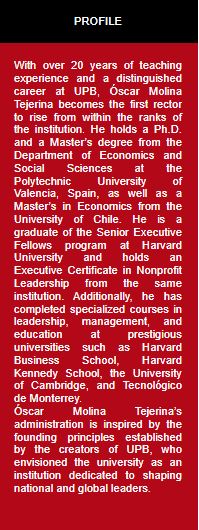ISSUE 141 | 2025
Vesna Marinkovic U.
1As the new rector of UPB, what do you see as the role of academia in the energy transition?
Academia must educate future professionals committed to environmental care, the sustainable and responsible use of natural resources, and the research and application of environmentally friendly energy sources.
Furthermore, academia must act as a bridge to facilitate the rapid adoption of emerging renewable energy technologies, particularly in the Global South. While the advantages of energy sources such as solar are evident, there are still several financial, infrastructural, and even legal barriers that hinder the widespread deployment of renewable energies. Although various studies demonstrate the solar potential of the Bolivian highlands, few public or private solar farm projects have been implemented. This is where academia must step in and quantitatively demonstrate the benefits of the energy transition.
At the same time, as an academic institution, we practice the energy transition ourselves by shifting toward renewable and clean energy. We generate between 25% and 50% of the energy we consume on our campuses in Cochabamba, La Paz, and Santa Cruz (mainly through solar energy). Additionally, we measure our carbon footprint and have set goals to reduce it to a minimum by 2030. We also have research centers specialized in renewable energy, which carry out studies, publish papers, develop prototypes, and even seek to patent their innovations.
2Do you think it’s important to promote energy education in Bolivia?
Absolutely. I believe it is essential to raise awareness and educate our population on the proper use of energy, avoiding waste unless justified. It is also important to support companies that integrate energy efficiency into their processes and those that are involved in alternative energy generation.
Clearly, the educational curriculum must be adapted to align with the energy transition and the Sustainable Development Goals outlined in the 2030 Agenda particularly Goals 5 and 7. However, I believe that a reform of this scale would require a complete retraining of the teaching staff and a redefinition of educational content by level. There are already scientific references where comprehensive studies have led to the reformulation of educational processes.


3In this regard, should certain teaching and undergraduate programs be modified to include energy education as an added component to the professional degree?
Yes. Courses related to alternative energy sources and energy management should be included. Energy education is embedded in these subjects. At UPB, for instance, the Environmental and Alternative Energy Engineering program embraces this approach.
In engineering programs such as Industrial Engineering, Electromechanical Engineering, and similar disciplines, curricula are being adapted to address the design, implementation, and maintenance of renewable energy systems. In fact, we’ve already been doing this for some time.
What’s particularly interesting is the challenge of integrating energy education into programs that may initially seem disconnected—for example, how to incorporate environmental education into fields like Communications and Journalism, or Graphic Design. This is where the creativity and didactic flexibility of the instructor plays a key role.

“…diversifying the energy matrix is a way to shield ourselves from any disruptions in primary energy sources.”
4What is the impact of the energy transition in countries that do not have fossil fuels?
An adequate energy transition in countries without natural hydrocarbon resources can have a moderate to high impact, depending on the type(s) of alternative energy sources adopted. These include biomass and biofuels, the production of various types of hydrogen, the use of wind power, photovoltaic radiation, geothermal energy, and/or rare earth elements. The selected energy source will also depend on the type and quantity of natural precursors present in the country.
Let me give you two simple examples:
A local example is the department of Pando, which is not connected to the national electric grid. As a result, electricity generation is carried out privately and independently. Although diesel generators are still common, more and more people are implementing their own solar photovoltaic systems.
On an international level, the best example is Germany. Due to the war between Ukraine and Russia, Germany’s massive natural gas imports from Russia were cut off. As a result, winter heating in Europe was put at risk. This forced Germany to seek local alternative energy sources, strengthening its nuclear energy production (considered a non-conventional renewable source). In fact, as the German Chancellor at the time stated, Germany is no longer dependent on Russian gas.

5In countries with fossil fuel resources, should the energy transition be slower?
That depends on the policies of each country. The transition of the energy matrix can be planned based on the size of the hydrocarbon reserves within a territory. If reserves are large, the transition doesn’t need to be rushed. However, if the country is strongly committed to environmental goals, the shift should be moderate to fast, depending on the type of alternative energy selected.
It is also important to point out that countries with hydrocarbon resources should maintain some level of production for petrochemical products that cannot yet be replaced by new energy sources.
6Is it possible and necessary to reach net-zero emissions on a global scale?
Net-zero emissions of greenhouse gases or carbon dioxide do not truly exist. However, with the introduction of new energy sources, emissions can be significantly reduced. The extent of this reduction depends on the selected energy source, with green hydrogen being the most environmentally friendly, followed by liquid biofuels.
7What is the fundamental impact of energy on a country’s economy?
The impact is tremendous. Any disruption in the energy chain is felt directly in people’s pockets. For example, in Bolivia’s energy matrix, over 50% of electricity is generated from thermal processes (gas-powered). A shortage of this fuel would trigger a domino effect, starting with higher service costs.
That’s why diversifying the energy matrix is a way to shield ourselves from any disruptions in primary energy sources.

8As the new head of UPB, you have emphasized the importance of combining a strong academic foundation with modern educational and technological tools. What are the other pillars of your administration?
• Academic Excellence with International Standards:
We aim to raise UPB’s academic quality to an international level, consolidating it as a world-class institution. Although we already hold prestigious accreditations and strong rankings, we seek to deepen our focus on innovation and critical thinking.
• Inclusive Education and Access to Opportunities:
As a nonprofit foundation, UPB allocates over $4 million annually in scholarships for talented students from across the country. This commitment enables outstanding young people to access quality education regardless of their financial situation. • Internationalization and Strategic Partnerships:
We will strengthen our global presence through joint programs with renowned institutions like the University of London, and expand our offering of international degrees. This strategy seeks to enrich students’ academic experience and prepare them for a globalized job market.
• Training Ethical, Committed, and Holistic Leaders:
We will focus on developing leaders who are not only experts in their fields but also possess strong ethics and a commitment to sustainable development. Through minors specialized academic tracks—we aim to fully equip our students to compete in the job market.
• Innovation and Entrepreneurship:
We will foster a culture of innovation and entrepreneurship within the university community, encouraging the creation of creative solutions to current and future challenges.
• Social Responsibility and Community Engagement:
We will strengthen our commitment to social responsibility through projects that have a positive impact on society, aligning our efforts with the needs and aspirations of the Bolivian people.

